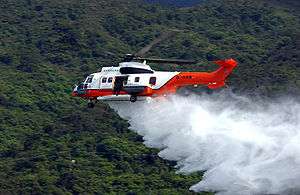Rotorcraft

A rotorcraft or rotary-wing aircraft[1] is a heavier-than-air flying machine that uses lift generated by wings, called rotary wings or rotor blades, that revolve around a mast. Several rotor blades mounted on a single mast are referred to as a rotor. The International Civil Aviation Organization (ICAO) defines a rotorcraft as "supported in flight by the reactions of the air on one or more rotors".[2] Rotorcraft generally include those aircraft where one or more rotors are required to provide lift throughout the entire flight, such as helicopters, cyclocopters, autogyros, and gyrodynes. Compound rotorcraft may also include additional thrust engines or propellers and static lifting surfaces.
Classes of rotorcraft
Helicopter
A helicopter is a rotorcraft whose rotors are driven by the engine(s) throughout the flight to allow the helicopter to take off vertically, hover, fly forwards, backwards and laterally, as well as to land vertically. Helicopters have several different configurations of one or more main rotors.
Helicopters with a single shaft-driven main lift rotor require some sort of antitorque device such as a tail rotor, fantail, or NOTAR, except some rare examples of helicopters using tip jet propulsion, which generates almost no torque.
Cyclogyro/Cyclocopter
A cyclocopter is a rotorcraft whose rotors are also driven by the engine throughout the flight, but the blades rotate about the horizontal axis while being parallel to it. They are being developed in a number of countries in order to replace the helicopters, which have a number of very serious shortcomings such as low efficiency in forward flight, low speed, very high noise and vibration levels, limited flight range, and low altitude ceiling. At the present time flying model prototypes have been built in China, US, S. Korea and Austria.
Autogyro

An autogyro (sometimes called gyrocopter, gyroplane, or rotaplane) utilizes an unpowered rotor, driven by aerodynamic forces in a state of autorotation to develop lift, and an engine-powered propeller, similar to that of a fixed-wing aircraft, to provide thrust. While similar to a helicopter rotor in appearance, the autogyro's rotor must have air flowing up and through the rotor disk in order to generate rotation. Early autogyros resembled the fixed-wing aircraft of the day, with wings and a front-mounted engine and propeller in a tractor configuration to pull the aircraft through the air. Late-model autogyros feature a rear-mounted engine and propeller in a pusher configuration.
The autogyro was invented in 1920 by Juan de la Cierva. The autogyro with pusher propeller was first tested by Etienne Dormoy with his Buhl A-1 Autogyro.
Gyrodyne

The rotor of a gyrodyne is normally driven by its engine for takeoff and landing—hovering like a helicopter—with anti-torque and propulsion for forward flight provided by one or more propellers mounted on short or stub wings. As power is increased to the propeller, less power is required by the rotor to provide forward thrust resulting in reduced pitch angles and rotor blade flapping. At cruise speeds with most or all of the thrust being provided by the propellers, the rotor receives power only sufficient to overcome the profile drag and maintain lift. The effect is a rotorcraft operating in a more efficient manner than the freewheeling rotor of an autogyro in autorotation, minimizing the adverse effects of retreating blade stall of helicopters at higher airspeeds.
Rotor kite
A rotor kite or gyroglider is an unpowered rotary-wing aircraft. Like an autogyro or helicopter, it relies on lift created by one or more sets of rotors in order to fly. Unlike a helicopter, autogyros and rotor kites do not have an engine powering their rotors, but while an autogyro has an engine providing forward thrust that keeps the rotor turning, a rotor kite has no engine at all, and relies on either being carried aloft and dropped from another aircraft, or by being towed into the air behind a car or boat.
Rotor configuration
Number of blades
A rotary wing is characterised by the number of blades. Typically this is between two and six per driveshaft.
Number of rotors
A rotorcraft may have one or more rotors. Various rotor configurations have been used:
- One rotor. Powered rotors require compensation for the torque reaction causing yaw, except in the case of tipjet drive.
- Two rotors. These typically rotate in opposite directions cancelling the torque reaction so that no tail rotor or other yaw stabiliser is needed. These rotors can be laid out as
- Tandem - One in front of the other.
- Transverse - Side by side.
- Coaxial - One rotor disc above the other, with concentric drive shafts.
- Intermeshing rotors - Twin rotors at an acute angle from each other, whose nearly-vertical driveshafts are geared together to synchronise their rotor blades so that they intermesh, also called a synchropter.
- Three rotors. An uncommon configuration; the 1948 Cierva Air Horse had three rotors as it was not believed a single rotor of sufficient strength could be built for its size. All three rotors turned in the same direction and yaw compensation was provided by inclining each rotor axis to generate rotor thrust components that opposed torque.
- Four rotors. Also referred to as quadcopters/quadrotors, they typically have two rotors turning clockwise and two counter-clockwise.
- More than four rotors. These designs (referred to generally as multirotors, or sometimes individually as hexacopters[4] and octocopters[5]), have matched sets of rotors turning in opposite directions, and uncommon in full-size manned aircraft, but commonly seen in unmanned aerial vehicle systems.
See also
History of rotorcraft:
Types of aircraft:
References
- ↑ Oxford English Dictionary
- ↑ "ICAO Annex 7." Retrieved on 30 September 2009.
- ↑ Photo: J Thinesen, SFF photo archive
- ↑ "Hexacopter - the radio controlled hexacopter flying machine".
- ↑ "Octocopter will someday kill someone - Hack a Day".
External links
| Wikimedia Commons has media related to Rotorcraft. |
